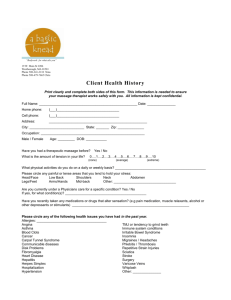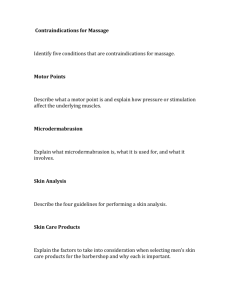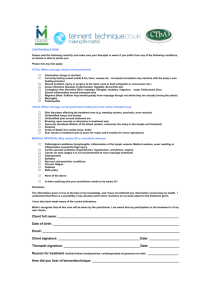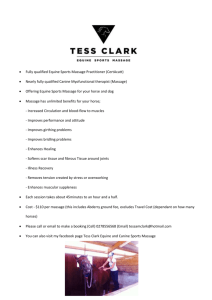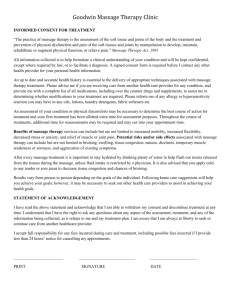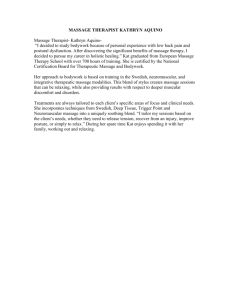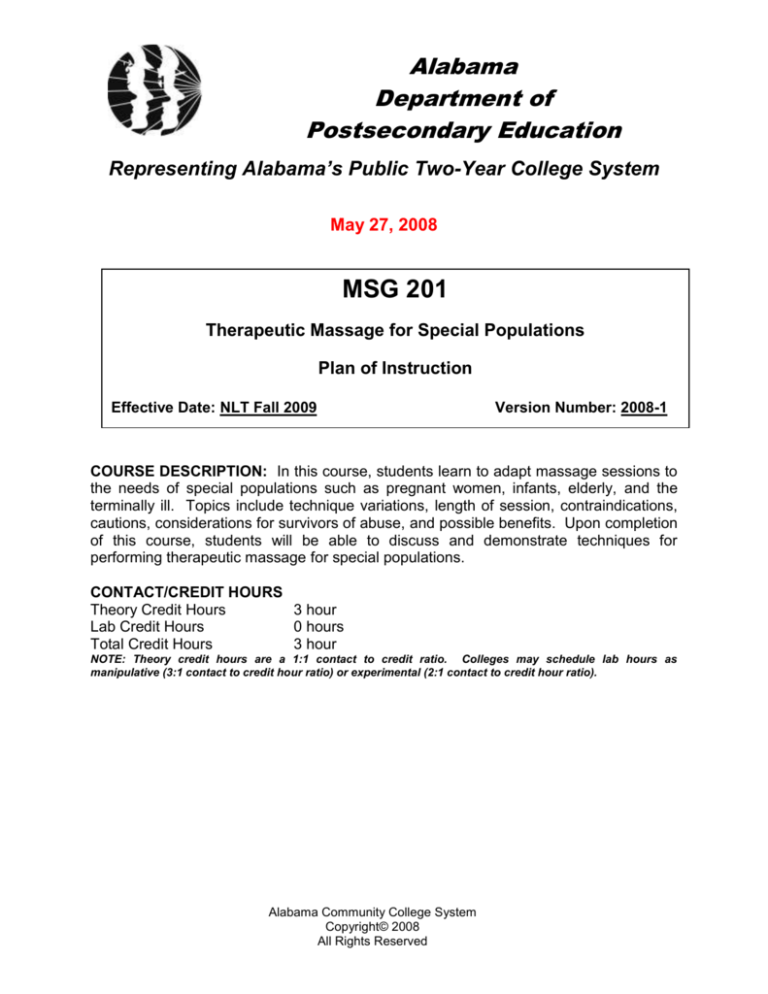
Alabama
Department of
Postsecondary Education
Representing Alabama’s Public Two-Year College System
May 27, 2008
MSG 201
Therapeutic Massage for Special Populations
Plan of Instruction
Effective Date: NLT Fall 2009
Version Number: 2008-1
COURSE DESCRIPTION: In this course, students learn to adapt massage sessions to
the needs of special populations such as pregnant women, infants, elderly, and the
terminally ill. Topics include technique variations, length of session, contraindications,
cautions, considerations for survivors of abuse, and possible benefits. Upon completion
of this course, students will be able to discuss and demonstrate techniques for
performing therapeutic massage for special populations.
CONTACT/CREDIT HOURS
Theory Credit Hours
3 hour
Lab Credit Hours
0 hours
Total Credit Hours
3 hour
NOTE: Theory credit hours are a 1:1 contact to credit ratio. Colleges may schedule lab hours as
manipulative (3:1 contact to credit hour ratio) or experimental (2:1 contact to credit hour ratio).
Alabama Community College System
Copyright© 2008
All Rights Reserved
Therapeutic Massage for Special Populations
MSG 201
PREREQUISITE COURSES
As determined by college.
CO-REQUISITE COURSES
As determined by college.
INSTRUCTIONAL NOTE: Due to unique situations, client needs, and limited lab
situations, students may perform techniques in clinical environments.
Include
information in each module regarding special considerations for performing therapeutic
massage for survivors of abuse.
Information in the various modules is introductory information only. Students will not be
certified to perform these techniques at this time. These require separate certifications
for practice of specific techniques. Instructors must ensure students understand this
requirement.
PROFESSIONAL COMPETENCIES
Modify therapeutic massage techniques to meet the needs of special populations.
INSTRUCTIONAL GOALS
Cognitive – Comprehend how to adapt therapeutic massage techniques to meet the
needs of special populations.
Psychomotor – Apply knowledge of how to adapt therapeutic massage techniques to
meet the needs of special populations.
Affective – Value the importance of following procedures for therapeutic massage.
PROFESSIONAL COMPETENCIES/OBJECTIVES
Unless otherwise indicated, evaluation of student’s attainment of objectives is based on
knowledge gained from this course. Specifications may be in the form of, but not limited
to, cognitive skills diagnostic instruments, manufacturer’s specifications, technical
orders, regulations, national and state codes, certification agencies, locally developed
lab/clinical assignments, or any combination of specifications.
ACCS Copyright© 2008
All Rights Reserved
2
Therapeutic Massage for Special Populations
MSG 201
MODULE A – INTRODUCTION TO PREGNANCY MASSAGE
PROFESSIONAL COMPETENCIES
PERFORMANCE OBJECTIVES
A1.0 Modify therapeutic massage
A1.1 Perform therapeutic massage for
techniques to meet the needs of
pregnant clients.
special populations.
LEARNING OBJECTIVES
A1.1.1 Describe benefits of therapeutic massage for various phases of pregnancy.
A1.1.2 Describe techniques to ensure an appropriate environment to perform
therapeutic massage for pregnant clients.
A1.1.3 Describe contraindications and precautions associated with therapeutic
massage for pregnant clients.
A1.1.4 Describe modifications to techniques, draping, and positioning for
performing therapeutic massage for pregnant clients.
MODULE A OUTLINE:
General information
- Benefits
° During pregnancy
° Labor, delivery, and recovery
° Postpartum
° Nursing mothers
- Setting the environment
- Contraindications and cautions
Positioning
Draping
Massage techniques
- Critical modifications
- Effleurage
- Tapotements
- Joint movements
- Vibrations
- Friction
- Knead
- Other
ACCS Copyright© 2008
All Rights Reserved
KSA
Indicators
2c
B
B
B
b
3
Therapeutic Massage for Special Populations
MSG 201
MODULE B – INFANTS AND CHILDREN
PROFESSIONAL COMPETENCIES
PERFORMANCE OBJECTIVES
B1.0 Modify therapeutic massage
B1.1 Perform therapeutic massage for
techniques to meet the needs of
infants and children.
special populations.
LEARNING OBJECTIVES
B1.1.1 Describe benefits of therapeutic massage for infants and children.
B1.1.2 Describe techniques to ensure an appropriate environment to perform
therapeutic massage for infants and children.
B1.1.3 Describe contraindications and precautions associated with therapeutic
massage for infants and children.
B1.1.4 Describe modifications to techniques, draping, and positioning for
performing therapeutic massage for infants and children.
MODULE B OUTLINE:
General information
- Benefits
- Setting the environment
- Contraindications and cautions
Positioning
Draping
Massage techniques
- Joint movements
- Stroking
- Pressing and squeezing
- Circle motions
- Other
ACCS Copyright© 2008
All Rights Reserved
KSA
Indicators
2c
B
B
B
b
4
Therapeutic Massage for Special Populations
MSG 201
MODULE C – ELDERLY
PROFESSIONAL COMPETENCIES
PERFORMANCE OBJECTIVES
C1.0 Modify therapeutic massage
C1.1 Perform therapeutic massage for
techniques to meet the needs of
elderly clients.
special populations.
LEARNING OBJECTIVES
C1.1.1 Describe benefits of therapeutic massage for elderly clients.
C1.1.2 Describe techniques to ensure an appropriate environment to perform
therapeutic massage for elderly clients.
C1.1.3 Describe contraindications and precautions associated with therapeutic
massage for elderly clients.
C1.1.4 Describe modifications to techniques, draping, and positioning for
performing therapeutic massage for elderly clients.
MODULE C OUTLINE:
General information
- Benefits
- Setting the environment
- Contraindications and cautions
- Special considerations
° Assessing body structure and needs
° Assessing physiological and chronological age
Positioning
Draping
Massage techniques
ACCS Copyright© 2008
All Rights Reserved
KSA
Indicators
2c
B
B
B
b
5
Therapeutic Massage for Special Populations
MSG 201
MODULE D – CRITICALLY AND TERMINALLY ILL CLIENTS
PROFESSIONAL COMPETENCIES
PERFORMANCE OBJECTIVES
D1.0 Modify therapeutic massage
D1.1 Perform therapeutic massage for
techniques to meet the needs of
critically and terminally ill clients.
special populations.
LEARNING OBJECTIVES
D1.1.1 Describe benefits of therapeutic massage for critically and terminally ill
clients.
D1.1.2 Describe techniques to ensure an appropriate environment to perform
therapeutic massage for critically and terminally ill clients.
D1.1.3 Describe contraindications and precautions associated with therapeutic
massage for critically and terminally ill clients.
D1.1.4 Describe modifications to techniques, draping, and positioning for
performing therapeutic massage for critically and terminally ill clients.
MODULE D OUTLINE:
General information
- Benefits
- Setting the environment
- Contraindications and cautions
- Special considerations
- Hospice
Positioning
Draping
Massage techniques
ACCS Copyright© 2008
All Rights Reserved
KSA
Indicators
2c
B
B
B
b
6
Therapeutic Massage for Special Populations
MSG 201
MODULE E – CLIENTS WITH INJURIES AND DISABILITIES
PROFESSIONAL COMPETENCIES
PERFORMANCE OBJECTIVES
E1.0 Modify therapeutic massage
E1.1 Perform therapeutic massage for
techniques to meet the needs of
clients with injuries and
special populations.
disabilities.
LEARNING OBJECTIVES
E1.1.1 Describe benefits of therapeutic massage for clients with injuries and
disabilities.
E1.1.2 Describe techniques to ensure an appropriate environment to perform
therapeutic massage for clients with injuries and disabilities.
E1.1.3 Describe contraindications and precautions associated with therapeutic
massage for clients with injuries and disabilities.
E1.1.4 Describe modifications to techniques, draping, and positioning for
performing therapeutic massage for clients with injuries and disabilities.
MODULE E OUTLINE:
General information
- Benefits
- Setting the environment
- Contraindications and cautions
- Special considerations
- Hospice
Positioning
Draping
Massage techniques
ACCS Copyright© 2008
All Rights Reserved
KSA
Indicators
2c
B
B
B
b
7
Therapeutic Massage for Special Populations
MSG 201
LEARNING OBJECTIVES TABLE OF SPECIFICATIONS
The table below identifies the percentage of cognitive objectives for each module.
Instructors should develop sufficient numbers of test items at the appropriate
level of evaluation.
Facts/
Nomenclature
Principles/
Procedures
A/a
-
B/b
100%
100%
100%
100%
100%
Module A
Module B
Module C
Module D
Module E
ACCS Copyright© 2008
All Rights Reserved
Analysis/
Operating
Principles
C/c
-
Evaluation/
Complete
Theory
D/d
-
8
Therapeutic Massage for Special Populations
MSG 201
Knowledge, Skills, and Attitudes (KSA) Indicators
Value
Key Word(s)
Highly
Proficient
Affective
Knowledge
Knowledge of Skills
Performance
Ability
4
Definition
Performs competency quickly and accurately. Instructs others how to do
the competency.
Performs all parts of the competency. Needs only a spot check of
completed work.
3
Proficient
2
Partially
Proficient
Performs most parts of the competency. Needs help only on hardest parts.
1
Limited Proficiency
Performs simple parts of the competency. Needs to be told or shown how
to do most of the competency.
Complete
Theory
Operating
Principles
d
c
Predicts, isolates, and resolves problems about the competency.
Identifies why and when the competency must be done and why each step
is needed.
b
Procedures
Determines step-by-step procedures for doing the competency.
a
Nomenclature
D
Evaluation
C
Analysis
Analyzes facts and principles and draws conclusions about the subject.
B
Principles
Identifies relationship of basic facts and states general principles about the
subject.
A
Facts
*5
Characterization by
Value
*4
Organization
*3
Valuing
*2
Responding
*1
Receiving
Names parts, tools, and simple facts about the competency.
Evaluates conditions and makes proper decisions about the subject.
Identifies basic facts and terms about the subject.
Acting consistently with the new value
Integrating a new value into one's general set of values, giving it some
ranking among one's general priorities
Showing some definite involvement or commitment
Showing some new behaviors as a result of experience
Being aware of or attending to something in the environment
Alpha Scale Values - Any item with an upper case letter (A, B, C, D) by itself is taught as general information on a topic. This information may be related to the
competency or encompass multiple competencies. Examples might include mathematical computations or knowledge of principles such as Ohm’s Law.
A lower case letter indicates a level of ”Knowledge of Skills." Individuals are taught information pertaining to performing a competency . These may be indicated
alone or in conjunction with a numerical scale value. A lower case letter by itself indicates the individual is not required to perform the task-just know about the task.
(example: Can state or explain procedures for doing a task).
Numerical Scale Values - The numbers reflect the levels the individual will be able to perform a competency. Number values are always accompanied by lower
case letters (i.e. 1a, 2b, 3c...etc.) in order to specify the level of knowledge of skills associated with the competency.
Example: An individual with a competency with a scale indicator of 3b has received training of knowledge of skills whereby he or she can determine the correct
procedures and perform with limited supervision; only requiring evaluation of the finished product or procedure.
Asterisk items indicate desired affective domain levels and are used to indicate the desired level for a given competency. They may be used independently or with
other indicators (i.e. 1a-*1, 2c-*3). If used with another indicator, separate with a hyphen.
NOTE: Codes indicate terminal values.
ACCS Copyright© 2008
All Rights Reserved
9

